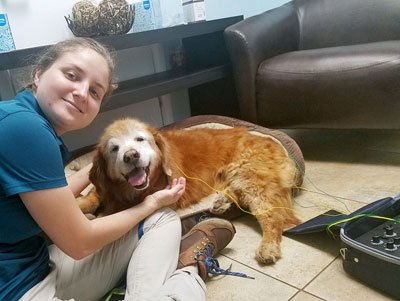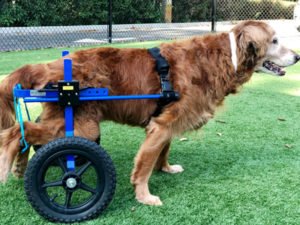Helping You Adjust to Your Pet’s New Abilities: Managing Neurological Disorders

Neurological disorders are diseases that affect the brain, spinal cord, or peripheral nerves (nerve after it exits the spinal cord). Symptoms range from seizures, head tilt, unsteady gait, weakness or complete paralysis of one or more limbs, decreased sensation in the limbs, and incontinence. Some diseases are progressive and others are stable. Pets with neurological disorders are at a higher risk for developing complications such as: muscle and ligament shortening in affected limbs, muscle atrophy (wasting), bed sores, urine/fecal scald, urinary tract infections, respiratory infections, and damage of limbs due to sensation loss. With your help and a few changes, your pet can live a happy and healthy life.
Neurological Disorders in Pets
The diagnosis of a neurological disorder can be scary, however there are many things that you can do to keep your pet a healthy and happy member of your family. One of the most important things that you can do is obtain a diagnosis. Your veterinarian will help to establish the appropriate diagnosis and devise a treatment plan. They may also refer you to a specialist. Without a diagnosis, it is very difficult to establish an effective treatment plan to help your pet.
Mobility aides: devices that help to keep your pet mobile and help you care for your pet.
 Slings: Help your pet to transition from sitting/lying to standing, used on a short term basis. Visit walkaboutharnessess.com for more info.
Slings: Help your pet to transition from sitting/lying to standing, used on a short term basis. Visit walkaboutharnessess.com for more info.- Harness systems: For front limb, hind limb, or combination support that can be worn all day. Visit helpemup.com for more info.
- Carts/Wheelchairs: If your pet has severe weakness of front or hind limbs or if legs are paralyzed. Best if custom fitted to pet. Visit walkinwheels.com and eddieswheels.com for more info.
Incontinence: Pet is unable to control bowel or bladder function. Establish a more frequent bathroom schedule with potty breaks every 1-2 hours and increase duration by 1 hour as pet is able. “Doggy diapers” are available at most pet stores, however be sure to check your pet often in order to keep him/her clean and dry to prevent urine/fecal scald. If your dog needs his bladder expressed, your veterinarian will instruct you in how to do this.
Home Environment Modifications:
- Place area rugs or carpet runners so that your pet will have improved traction when walking and decrease the chance of slipping.
- Contain your dog to the first floor so that he does not need to go up/down stairs.
- Use a ramp with a non-skid surface or harness system to get in/out of the house if stairs are necessary.
- Keep your pet’s food and water bowls in an easily accessible location.
- Provide well-padded comfortable bedding. Place an absorbent pad on bedding to absorb urine and feces away from pet.
- If your pet is unable to move his/her limbs, be sure to change his/her position every 4 hours at a minimum to decrease the risk for developing bed sores
Physical Rehabilitation: Work with a qualified professional to decrease your pet’s pain and improve or maintain your pet’s mobility. Our Rehabilitation Therapist can evaluate your pet, develop an exercise program, and instruct you in safe ways to perform passive range of motion, stretching, and massage techniques to help keep your pet comfortable. Rehabilitation can help to prevent muscle/ligament shortening as well as improve or maintain muscle flexibility, joint range of motion, muscle strength, balance, and ability to walk.
If you are interested in finding out more about rehabilitation, please ask your veterinarian for a referral.
- Behavior (11)
- Caring for your pet (263)
- cat (4)
- Community Events (19)
- dog (6)
- From Our Clients (15)
- Happy Tails (8)
- News (418)
- Press (53)
- Products (2)
- Questions (4)
- Recalls (1)
- Special Offers (5)
- Tips & Advice (231)
- Uncategorized (19)
- Veterinary Services (48)
